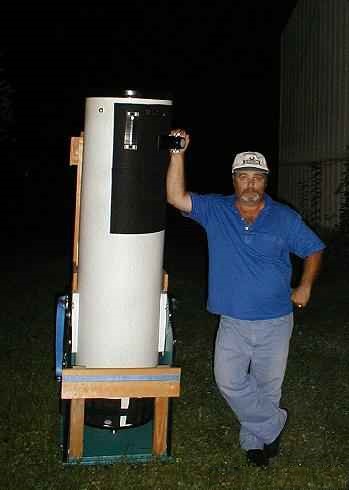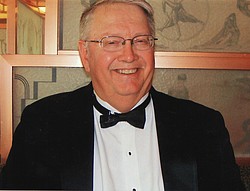In 2014, we at SMAS lost two of our treasured members and friends. Although we are deeply saddened to know that we will never see them again on this earth, we can take solace, knowing that we will be reminded of them whenever we ponder the night sky, and imagine them among the stars.

Mike Conte left this mortal plane on April 29, 2014. He was one of the founding members of SMAS, because he started "hanging around" with other local amateur astronomers, and they decided to form the club. He continued his membership for nearly twenty years. Beginning in 1998, he served as the club's President, then transitioned to President Emeritus in 2002, which he remained until his death.
Mike's love of astronomy began at an early age. When asked to share any memorable stories from his "young astronomer" days, Mike replied, "The first was when I was about 15 years old and I was looking for Venus at twilight. I found a bright object in the sky that I thought was Venus, until I observed it in my telescope. It was a silvery object that had some kind of line or 'arm' that was rotating around it. I was sure I was seeing a 'UFO' and ran and got my neighbors. We watched it for a little bit until it exploded. [I] found out later it was a weather balloon that broke its tether and exploded in the rarified air of the upper stratosphere."
Mike also related, "The second was when I was a little older and was star sweeping in Gemini one winter night. I came across a diffuse glow that I couldn't figure out what it was and just shrugged it off. Later I found out it was an undiscovered (at that time) comet."
As time passed, Mike became highly skilled in many astronomical pursuits, including building and restoring telescopes, building his own observatory, asteroid hunting, astrophotography, and photometry of variable stars. He also taught astronomy at the College of Southern Maryland, mentored numerous fellow SMAS members, and shared the night sky with countless star party guests. Although his demeanor was quiet, it was easy to see Mike's joy when he shared his telescopic views and astronomy lessons in the field.
During his early astronomy days, Mike honed his skills by learning everything he could about the night sky with a basic Dobsonian telescope and the art of "star hopping." He was great at identifying stars, simply by looking at them in the sky. He once told the Program Coordinator that it is due to three simple things: practice, practice, practice! When he had mastered star hopping, he moved up to GoTo mounts, which he admitted made his life easier, not only for doing astrophotography, but because he would become impatient, wanting to see more and more things, and deeper into space.
Even with more affordable GoTo telescopes that many beginners choose, twenty plus years later, Mike still expressed his philosophy of learning the night sky "the old fashioned way," with a simple scope and star hopping. Mike believed new astronomers need a solid foundation in these basics, before they can "graduate" to more technical equipment and disciplines within astronomy. It is a philosophy that many SMAS members have adopted, too.
That is not to say Mike would look down upon those who were less skilled than he, as he was always the consummate teacher, willing and able to answer nearly any question that arose. When asked by a fellow SMAS member, who was much less technically skilled than Mike, "What is the speed of dark?" Mike replied with an almost imperceptible twinkle in his eye, "The same as the speed of light." "How is that possible?" the newbie asked. Mike explained in simple, yet unpatronizing terms. Both he and the newbie were aware that the concept would probably not sink in at that time, but she appreciated his efforts, nonetheless.
Mike may have summed up his own philosophy in the speech he wrote for the October 29, 2000 dedication ceremony of the Nanjemoy Creek Observatory. "We find ourselves gathered here to celebrate the achievements of a small group of individuals. A small group that had hoped to find a place where they could come together to enjoy, and share, the wonders of the night sky in the company of their friends. And, in the hope that someday they could have a place where the pursuit of education and research could be shared with anyone that wanted the opportunity to explore the beauty of the universe." He also observed, "To hear a young voice, and sometimes the not so young voice say 'Wow' at their first actual view of the Moon, or of Saturn and its rings made it worthwhile."
Perhaps that is the legacy for which we will be ever grateful to Mike Conte. Regardless of the age and skill level of his fellow astronomy enthusiasts, Mike was always ready to teach them more, and help them appreciate the wonders of the universe as much as he did.

Larry Taborek was called to his eternal rest on August 29, 2014. He first joined SMAS in 1999. The first time we met him in person was during a school star party. Larry had never worked at a large star party before, but he said that he was happy to get involved in the community outreach programs of SMAS. We explained the procedures of a star party to Larry. The SMAS members would set up their scopes in the field. The Program Coordinator would give a pre-observing briefing to the students and teachers in the meeting hall on the hill above the field, then she would lead them in a quiet and orderly fashion down the hill, divide the larger group into smaller groups and methodically guide them to each of the scopes. The guests would then look through each of their "first" scopes in the field, then be guided by the Program Coordinator to the next scope, and so on. By the end of the evening, each guest will have looked through all of the scopes.
As the Program Coordinator answered a couple of final questions after the pre-observing briefing at the front of the meeting hall, unbeknownst to her, the nearly two hundred students had left through the back door and were hurtling enthusiastically down the hill toward the scopes, waving their white light flashlights in every direction. The Program Coordinator followed them down the hill as fast as she could, and eventually restored order among the guests. Regardless of the dramatic start, the star party was a great success.
We laughed with Larry afterwards about his "baptism by fire," but he declared that he had a great time, and was looking forward to our next event. Since this was the first time we met Larry, we thought it quite possible he was merely being polite, and we decided that we would never see him again. Thankfully, we were wrong. Larry would continue to be a mainstay at many star parties over the years, happily sharing his night sky views with all guests, young and old. He would regale all who were privileged to step up to his eyepiece with animated descriptions of what they saw.
In the early 2000's, Larry suspended his SMAS membership to devote more time to his growing family's other activities. He returned to SMAS again in 2010 and renewed his enthusiastic support of the community outreach programs. Two years later, he was chatting with a fellow military veteran and SMAS member about different ways they might support other military veterans in our area. In his words, "We're looking for a few good men and women to give back to our vets and their spouses that have given us so much."
Knowing his love of the subject, astronomy was the logical answer. Larry created the "Stargazing" program for the residents of the Charlotte Hall Veterans Home, and would continue as its Program Coordinator until his death. His fellow SMAS members have continued their outdoor "Stargazing" visits at Charlotte Hall.
When the SMAS Program Coordinator once asked Larry what he liked about astronomy, the answer surprised her a little. He did not mention the usual topics, such as spending long hours searching for the elusive "dim fuzzies," or using sophisticated equipment to create the perfect astrophotograph. His favorite part of astronomy in general, and SMAS in particular, was the fellowship he found with other people, whether they were astronomers or star party guests. He told the story of a friend who was also an amateur astronomer, whom he had invited numerous times to join SMAS. The friend declined, citing that he could see the night sky just as well from his own backyard, all by himself. Larry replied, in his exuberant baritone voice, "Yeah, but where's the fun in that?"
Suddenly, the SMAS Program Coordinator had discovered the true meaning of Larry Taborek's astronomical life. The simple act of sharing the night sky with others was its own reward, and we will surely miss sharing our night sky with Larry.
Last Updated: 2/14/16